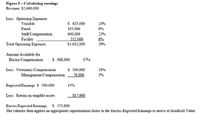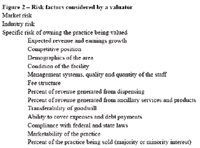Practice valuation: Determining the value of a client (Proceedings)
Veterinarians who are planning the sale of their practice often ask, "What is my client list worth?" When it comes to practice value, the short answer is nothing.
Veterinarians who are planning the sale of their practice often ask, "What is my client list worth?" When it comes to practice value, the short answer is nothing.
A big portion of practice value is tied to the earnings the practice generates for the owner after all normal operating expenses have been paid. While it's true that without clients there would be no earnings, the only true value of a client is the earnings. You may be saying to yourself, "Sounds like a circular argument to me." So, let's explore the long answer to the question.
Two common methods of valuing veterinary practices – single period capitalization and excess earnings – both entail capitalizing an earnings stream that is representative of the normal operations of the practice (see figure 1). This earnings stream determines the goodwill (intangible asset) value of the practice.

Figure 1 â Calculating earnings
The capitalization rate reflects the return the investor wants to achieve based on the risk associated with owning the practice. The valuator must consider multiple factors when determining the appropriate rate – general market risk, veterinary industry risk, and risk associated with the ownership of the specific practice being valued (see figure 2).

Figure 2 â Risk factors considered by a valuator
An investor wants to know what kind of return to expect on his or her investment. "What's the likelihood I'll recoup my investment and how many years will it take?" A capitalization rate of 25 percent means the investor is expecting to recoup the investment within 4 years (100/25 = 4, where 100 = investment and 25 = rate of return).
A client list in and of itself doesn't guarantee that those clients will remain with the practice – and generate earnings - after a sale. Typically an investor only wants to pay for what can reasonably be assured he or she will receive.
Dr. Darren Williams, owner of Mayde Creek Animal Health Center in Katy, TX says, "A client list has no intrinsic value. We have no exclusive contracts with our clients. They are not ours to keep and are free to seek veterinary care from any provider they choose. Therefore, a list of their names is simply a record of those individuals who have used our services in the past, not a guarantee that they'll continue to use our services."
Lorraine List, CPA, CVA, owner of Summit Veterinary Advisors in Littleton, CO agrees that a client list has no more value than the paper it's printed on. "The value of the list depends on whether those clients, and the earnings they represent, can actually be transferred to the purchaser. It's important to remember that no one actually "owns" clients – they always have choices on where they can get veterinary care for their animals. That's why the steps in an ownership transition are so critical," List states.
I was curious if corporate consolidators attached value to the client list when they purchase a practice, so I spoke with Dr. Stan Creighton and Mr. Greg Hartmann, MBA of National Veterinary Associates (NVA). "We don't attach a value to the client list per se," says Creighton. "The value of a client is primarily the earnings generated in the practice."
Hartmann added, "To a certain extent NVA ignores the number of active clients when we buy a practice. We do subjectively assess the number of new clients to determine the stability of the client base and the potential for us to minimize the client attrition rate over a period of time."
To add a practice broker's viewpoint to the discussion, I also talked with Larry McCormick, DVM, MBA, CBA, co-owner of The McCormick Consultant Group and Simmons & Associates Mid-Atlantic. McCormick believes in some very select situations, it is appropriate to attach value to the client list.
"If the acquiring practice has excess capacity to accommodate the influx of additional business, and it is reasonable to believe that the majority of the clients will make the transition to the new practice, the clients have value," he states. "When clients transfer from another practice, they bring the revenue they generate but no added fixed costs. Thus, the bottom-line gain from the transferring clients can be significant," McCormick explains. So how does he arrive at the value? By projecting (and capitalizing) the earnings the transferring clients will generate.
"Part of the confusion about putting a separate value on the client list comes from obsolete U.S. income tax law, which used to allow a faster write-off of the value of the client list and no write-off of purchased goodwill," states List. "So, buyers were motivated to put separate values on the client list. However, that law changed several years ago and current law allows a 15-year write-off of intangible assets, whether that asset is called "client list" or "goodwill"," she adds.
So from a valuation standpoint, it seems we're all in agreement. A client list has value if those clients generate earnings for the practice. The value of the client list is determined by the earnings, and the earnings are what truly determine practice value.
But isn't there more to consider when it comes to the value of a practice's client list? Is it more than just the financial dollars a client brings to the practice? What about the value of the relationship?
From a business perspective, the value of a client might equal the client's lifetime expenditures with the hospital. In the October 2007 issue of The Harvard Business Review, Kumar, Peterson, and Leone point out that this formula underestimates the true value of a client. "A client's true lifetime value incorporates her own expenditures with the business as well as the expenditures of new clients she refers, or her Customer Referral Value." Their research indicated that clients with the highest Customer Lifetime Value didn't necessarily have the highest Customer Referral Value.
"As a veterinarian who started my practice from nothing, the value of a client has been quite obvious, says Dr. Damon O'Gan, co-owner of Austin Equine Associates in Driftwood, TX. "The financial reward of one good client is worth a fraction of the goodwill which a happy client provides. The equine industry is very close knit, the owners and trainers are often extremely knowledgeable, and they all love to talk horses. If we take good care of a client, it often results in five new clients directly gained by the satisfied owner's or trainer's referral," he adds.
Dr. O'Gan shared this experience. "Recently we were visited by a new client with a miniature donkey that was having difficulty becoming pregnant. We weren't terribly excited about dealing with the breeding of miniature donkeys, but we're always happy to meet a new client. Not only has this become a wonderful client and a good friend, but her experience and influence in the industry in our area has benefited us greatly. She's our loudest cheerleader, and has brought numerous new clients from various disciplines to our practice in a very short time. Reputation is critical in equine practice, and it is the client that perceives and spreads a good reputation, resulting in more growth than any amount of advertising I can imagine."
Dr. Williams believes it's important to focus energy and attention not just on clients who are the biggest spenders, the so-called "A" clients, but also on the clients who are the biggest source of referrals (he calls them Advocates). "The value derived from an impassioned Advocate who makes numerous referrals has the potential to outweigh the value derived from a Big Spender," Williams says. "In my practice, we want to identify – and cater to the needs of – our Advocates just as thoroughly as we do our Big Spenders," he adds.
Dr. Keith Brady, co-owner of Old Dominion Equine Associates in Keswick, VA, says his practice has three types of clients: Type A – clients who know you and utilize your services; Type B – potential clients who know you but utilize a different practice; and Type C – potential clients who don't know you and don't utilize your services. "Our philosophy is to spend 95 percent of our effort on Type A clients, 5 percent on Type B clients, and forget about Type C clients," states Brady. "Equine practices often have a few prominent clients (owners and/or trainers) who control large swathes of revenue, so maintaining good relationships with them is paramount to our success," he adds.
"Shouldn't a client relationship be worth something?" asks Dr. Brent Cook, co-owner of Kingsbrook Animal Hospital in Frederick, MD. "We've invested significant dollars to get clients, worked long hours to keep them, and spent years teaching them to be responsible pet owners, so that definitely has value – but it's the relationships that we value," Cook says. "Remember the last time one of your clients requested his records? Was your first thought, "I just lost $2,433 over the course of the next few years?" Or, was it "What didn't they like about me?"
When it comes to the value of a client relationship, I agree with all of the doctors cited here. It's not just about the money – it's also about the relationship, the referrals, and the fact that you like them – they're fun to work with (well, most of them).
"As a veterinarian, I can't stand the thought that someone may not like me," states Cook. "Oh sure, I like it when clients pay for our services, but what really makes me smile at the end of the day is when a client says something nice about me or a staff member, sends us a gift, bakes us a cake, or writes a note thanking us for what we've done. What I really crave from my clients is a relationship. And your consultant is right – you can't put a price on that."